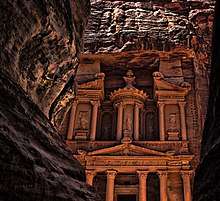History of the Arabs
The history of the Arabs begins in the mid-ninth century BC, which is the earliest known attestation of the Old Arabic language. The Arabs appear to have been under the vassalage of the Neo-Assyrian Empire; they went from the Arabian Peninsula to Mauritania.[2] Arab tribes, most notably the Ghassanids and Lakhmids, begin to appear in the southern Syrian Desert from the mid-third century CE onward, during the mid to later stages of the Roman and Sasanian empires.[3] Tradition holds that Arabs descend from Ishmael, the son of Abraham.[4] The Arabian Desert is the birthplace of "Arab",[5] as well other Arab groups that spread in the land and existed for millennia.[6]
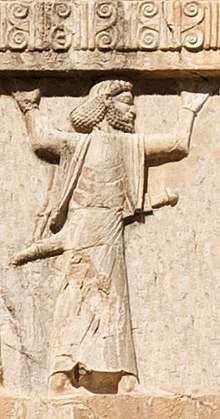
Before the expansion of the Rashidun Caliphate (632–661), "Arab" referred to any of the largely nomadic and settled Semitic people from the Arabian Peninsula, Syrian Desert, North and Lower Mesopotamia.[7] Today, "Arab" refers to a large number of people whose native regions form the Arab world due to the spread of Arabs and the Arabic language throughout the region during the early Muslim conquests of the 7th and 8th centuries.[8] The Arabs forged the Rashidun (632–661), Umayyad (661–750) and the Abbasid (750–1258) caliphates, whose borders reached southern France in the west, China in the east, Anatolia in the north, and the Sudan in the south. This was one of the largest land empires in history.[9] In the early 20th century, the First World War signalled the end of the Ottoman Empire; which had ruled much of the Arab world since conquering the Mamluk Sultanate in 1517.[10] This resulted in the defeat and dissolution of the empire and the partition of its territories, forming the modern Arab states.[11] Following the adoption of the Alexandria Protocol in 1944, the Arab League was founded on 22 March 1945.[12] The Charter of the Arab League endorsed the principle of an Arab homeland whilst respecting the individual sovereignty of its member states.[13]
Antiquity
| Historical Arab states and dynasties | ||||||||||||||||||||||||||||||||||||||||||||||||||||||||||
|---|---|---|---|---|---|---|---|---|---|---|---|---|---|---|---|---|---|---|---|---|---|---|---|---|---|---|---|---|---|---|---|---|---|---|---|---|---|---|---|---|---|---|---|---|---|---|---|---|---|---|---|---|---|---|---|---|---|---|
 | ||||||||||||||||||||||||||||||||||||||||||||||||||||||||||
|
Ancient Arab States
|
||||||||||||||||||||||||||||||||||||||||||||||||||||||||||
|
Arab Empires
|
||||||||||||||||||||||||||||||||||||||||||||||||||||||||||
|
Eastern Dynasties
|
||||||||||||||||||||||||||||||||||||||||||||||||||||||||||
|
Western Dynasties
|
||||||||||||||||||||||||||||||||||||||||||||||||||||||||||
|
Arabian Peninsula
|
||||||||||||||||||||||||||||||||||||||||||||||||||||||||||
|
East Africa
|
||||||||||||||||||||||||||||||||||||||||||||||||||||||||||
|
Current monarchies
|
||||||||||||||||||||||||||||||||||||||||||||||||||||||||||
Pre-Islamic Arabia refers to the Arabian Peninsula prior to the rise of Islam in the 630s. The study of Pre-Islamic Arabia is important to Islamic studies as it provides the context for the development of Islam. Some of the settled communities in the Arabian Peninsula developed into distinctive civilizations. Sources for these civilizations are not extensive, and are limited to archaeological evidence, accounts written outside of Arabia, and Arab oral traditions later recorded by Islamic scholars. Among the most prominent civilizations was Dilmun, which arose around the 4th millennium BC and lasted to 538 BC, and Thamud, which arose around the 1st millennium BC and lasted to about 300 CE. Additionally, from the beginning of the first millennium BC, Southern Arabia was the home to a number of kingdoms, such as the Sabaean kingdom, and the coastal areas of Eastern Arabia were controlled by the Parthian and Sassanians from 300 BC.
Classical kingdoms
Proto-Arabic, or Ancient North Arabian, texts give a clearer picture of the Arabs' emergence. The earliest are written in variants of epigraphic south Arabian musnad script, including the 8th century BCE Hasaean inscriptions of eastern Arabia, the 6th century BCE Lihyanite texts of southeastern Saudi Arabia and the Thamudic texts found throughout the Arabian Peninsula and Sinai (not in reality connected with Thamud).
The Nabataeans were nomads who moved into territory vacated by the Edomites – Semites who settled the region centuries before them. Their early inscriptions were in Aramaic, but gradually switched to Arabic, and since they had writing, it was they who made the first inscriptions in Arabic. The Nabataean alphabet was adopted by Arabs to the south, and evolved into modern Arabic script around the 4th century. This is attested by Safaitic inscriptions (beginning in the 1st century BCE) and the many Arabic personal names in Nabataean inscriptions. From about the 2nd century BCE, a few inscriptions from Qaryat al-Faw reveal a dialect no longer considered proto-Arabic, but pre-classical Arabic. Five Syriac inscriptions mentioning Arabs have been found at Sumatar Harabesi, one of which dates to the 2nd century CE.
Arabs arrived in the Palmyra in the late first millennium BC.[14] The soldiers of the sheikh Zabdibel, who aided the Seleucids in the battle of Raphia (217 BC), were described as Arabs; Zabdibel and his men were not actually identified as Palmyrenes in the texts, but the name "Zabdibel" is a Palmyrene name leading to the conclusion that the sheikh hailed from Palmyra.[15] Palmyra was conquered by the Rashidun Caliphate after its 634 capture by the Arab general Khalid ibn al-Walid, who took the city on his way to Damascus; an 18-day march by his army through the Syrian Desert from Mesopotamia.[16] By then Palmyra was limited to the Diocletian camp.[17] After the conquest, the city became part of Homs Province.[18]

Palmyra prospered as part of the Umayyad Caliphate, and its population grew.[19] It was a key stop on the East-West trade route, with a large souq (market), built by the Umayyads,[19][20] who also commissioned part of the Temple of Bel as a mosque.[20] During this period, Palmyra was a stronghold of the Banu Kalb tribe.[21] After being defeated by Marwan II during a civil war in the caliphate, Umayyad contender Sulayman ibn Hisham fled to the Banu Kalb in Palmyra, but eventually pledged allegiance to Marwan in 744; Palmyra continued to oppose Marwan until the surrender of the Banu Kalb leader al-Abrash al-Kalbi in 745.[22] That year, Marwan ordered the city's walls demolished.[17][23] In 750 a revolt, led by Majza'a ibn al-Kawthar and Umayyad pretender Abu Muhammad al-Sufyani, against the new Abbasid Caliphate swept across Syria;[24] the tribes in Palmyra supported the rebels.[25] After his defeat Abu Muhammad took refuge in the city, which withstood an Abbasid assault long enough to allow him to escape.[25]
Late kingdoms

The Ghassanids, Lakhmids and Kindites were the last major migration of pre-Islamic Arabs out of Yemen to the north. The Ghassanids increased the Semitic presence in the then Hellenized Syria, the majority of Semites were Aramaic peoples. They mainly settled in the Hauran region and spread to modern Lebanon, Palestine and East Jordan.

Greeks and Romans referred to all the nomadic population of the desert in the Near East as Arabi. The Romans called Yemen "Arabia Felix".[26] The Romans called the vassal nomadic states within the Roman Empire Arabia Petraea, after the city of Petra, and called unconquered deserts bordering the empire to the south and east Arabia Magna.
The Lakhmids as a dynasty inherited their power from the Tanukhids, the mid Tigris region around their capital Al-Hira. They ended up allying with the Sassanids against the Ghassanids and the Byzantine Empire. The Lakhmids contested control of the Central Arabian tribes with the Kindites with the Lakhmids eventually destroying Kinda in 540 after the fall of their main ally Himyar. The Persian Sassanids dissolved the Lakhmid dynasty in 602, being under puppet kings, then under their direct control.[27] The Kindites migrated from Yemen along with the Ghassanids and Lakhmids, but were turned back in Bahrain by the Abdul Qais Rabi'a tribe. They returned to Yemen and allied themselves with the Himyarites who installed them as a vassal kingdom that ruled Central Arabia from "Qaryah Dhat Kahl" (the present-day called Qaryat al-Faw). They ruled much of the Northern/Central Arabian peninsula, until they were destroyed by the Lakhmid king Al-Mundhir, and his son 'Amr.
Medieval period
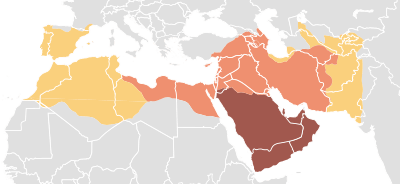
Rashidun Caliphate (632–661)
After the death of Muhammad in 632, Rashidun armies launched campaigns of conquest, establishing the Caliphate, or Islamic Empire, one of the largest empires in history. It was larger and lasted longer than the previous Arab empire of Queen Mawia or the Aramean-Arab Palmyrene Empire. The Rashidun state was a completely new state and unlike the Arab kingdoms of its century such as the Himyarite, Lakhmids or Ghassanids.
Umayyad Caliphate (661–750 & 756–1031)
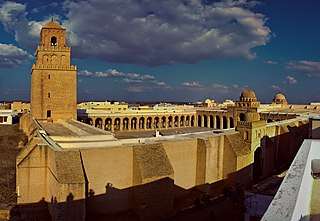

In 661, the Rashidun Caliphate fell into the hands of the Umayyad dynasty and Damascus was established as the empire's capital. The Umayyads were proud of their Arab identity and sponsored the poetry and culture of pre-Islamic Arabia. They established garrison towns at Ramla, Raqqa, Basra, Kufa, Mosul and Samarra, all of which developed into major cities.[29]
Caliph Abd al-Malik established Arabic as the Caliphate's official language in 686.[30] This reform greatly influenced the conquered non-Arab peoples and fueled the Arabization of the region. However, the Arabs' higher status among non-Arab Muslim converts and the latter's obligation to pay heavy taxes caused resentment. Caliph Umar II strove to resolve the conflict when he came to power in 717. He rectified the disparity, demanding that all Muslims be treated as equals, but his intended reforms did not take effect, as he died after only three years of rule. By now, discontent with the Umayyads swept the region and an uprising occurred in which the Abbasids came to power and moved the capital to Baghdad.

Umayyads expanded their Empire westwards capturing North Africa from the Byzantines. Before the Arab conquest, North Africa was conquered or settled by various people including Punics, Vandals and Romans. After the Abbasid Revolution, the Umayyads lost most of their territories with the exception of Iberia. Their last holding became known as the Emirate of Córdoba. It wasn't until the rule of the grandson of the founder of this new emirate that the state entered a new phase as the Caliphate of Córdoba. This new state was characterized by an expansion of trade, culture and knowledge, and saw the construction of masterpieces of al-Andalus architecture and the library of Al-Ḥakam II which housed over 400,000 volumes. With the collapse of the Umayyad state in 1031 AD, Islamic Spain was divided into small kingdoms.
Abbassid Caliphate (750–1258 & 1261–1517)
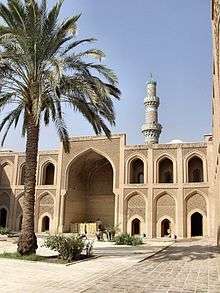

The Abbasids were the descendants of Abbas ibn Abd al-Muttalib, one of the youngest uncles of Muhammad and of the same Banu Hashim clan. The Abbasids led a revolt against the Umayyads and defeated them in the Battle of the Zab effectively ending their rule in all parts of the Empire with the exception of al-Andalus. In 762, the second Abbasid Caliph al-Mansur founded the city of Baghdad and declared it the capital of the Caliphate. Unlike the Umayyads, the Abbasids had the support of non-Arab subjects.[29]
The Islamic Golden Age was inaugurated by the middle of the 8th century by the ascension of the Abbasid Caliphate and the transfer of the capital from Damascus to the newly founded city of Baghdad. The Abbassids were influenced by the Qur'anic injunctions and hadith such as "The ink of the scholar is more holy than the blood of martyrs" stressing the value of knowledge. During this period the Muslim world became an intellectual centre for science, philosophy, medicine and education as the Abbasids championed the cause of knowledge and established the "House of Wisdom" (Arabic: بيت الحكمة) in Baghdad. Rival dynasties such as the Fatimids of Egypt and the Umayyads of al-Andalus were also major intellectual centres with cities such as Cairo and Córdoba rivaling Baghdad.[31]

The Abbasids ruled for 200 years before they lost their central control when Wilayas began to fracture in the 10th century; afterwards, in the 1190s, there was a revival of their power, which was ended by the Mongols, who conquered Baghdad in 1258 and killed the Caliph Al-Musta'sim. Members of the Abbasid royal family escaped the massacre and resorted to Cairo, which had broken from the Abbasid rule two years earlier; the Mamluk generals taking the political side of the kingdom while Abbasid Caliphs were engaged in civil activities and continued patronizing science, arts and literature.
Fatimid Caliphate (909–1171)

The Fatimid caliphate was founded by al-Mahdi Billah, a descendant of Fatimah, the daughter of Muhammad, in the early 10th century. Egypt was the political, cultural, and religious centre of the Fatimid empire. The Fatimid state took shape among the Kutama Berbers, in the West of the North African littoral, in Algeria, in 909 conquering Raqqada, the Aghlabid capital. In 921 the Fatimids established the Tunisian city of Mahdia as their new capital. In 948 they shifted their capital to Al-Mansuriya, near Kairouan in Tunisia, and in 969 they conquered Egypt and established Cairo as the capital of their caliphate.
Intellectual life in Egypt during the Fatimid period achieved great progress and activity, due to many scholars who lived in or came to Egypt, as well as the number of books available. Fatimid Caliphs gave prominent positions to scholars in their courts, encouraged students, and established libraries in their palaces, so that scholars might expand their knowledge and reap benefits from the work of their predecessors.[32] The Fatimids were also known for their exquisite arts. Many traces of Fatimid architecture exist in Cairo today; the most defining examples include the Al-Hakim Mosque and the Al-Azhar University.

It was not until the 11th century that the Maghreb saw a large influx of ethnic Arabs. Starting with the 11th century, the Arab bedouin Banu Hilal tribes migrated to the West. Having been sent by the Fatimids to punish the Berber Zirids for abandoning Shias, they travelled westwards. The Banu Hilal quickly defeated the Zirids and deeply weakened the neighboring Hammadids. According to some modern historians. their influx was a major factor in the arabization of the Maghreb.[33][34] Although Berbers ruled the region until the 16th century (under such powerful dynasties as the Almoravids, the Almohads, Hafsids, etc.).
Ottoman Empire (1299–1922/1923)
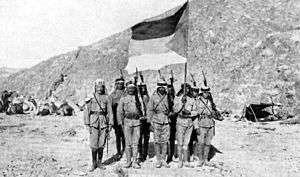
From 1517 to 1918, much of the Arab world was under the suzerainty of the Ottoman Empire. The Ottomans defeated the Mamluk Sultanate in Cairo, and ended the Abbasid Caliphate. Arabs did not feel the change of administration because the Ottomans modeled their rule after the previous Arab administration systems.
In 1911, Arab intellectuals and politicians from throughout the Levant formed al-Fatat ("the Young Arab Society"), a small Arab nationalist club, in Paris. Its stated aim was "raising the level of the Arab nation to the level of modern nations." In the first few years of its existence, al-Fatat called for greater autonomy within a unified Ottoman state rather than Arab independence from the empire. Al-Fatat hosted the Arab Congress of 1913 in Paris, the purpose of which was to discuss desired reforms with other dissenting individuals from the Arab world. However, as the Ottoman authorities cracked down on the organization's activities and members, al-Fatat went underground and demanded the complete independence and unity of the Arab provinces.[35]
After World War I, when the Ottoman Empire was overthrown by the British Empire, former Ottoman colonies were divided up between the British and French as League of Nations mandates.
Modern period
Arabs in modern times live in the Arab world, which comprises 22 countries in Western Asia, North Africa, and parts of the Horn of Africa. They are all modern states and became significant as distinct political entities after the fall and defeat and dissolution of the Ottoman Empire.
References
- DNa - Livius. p. DNa inscription Line 27.
-
- Bowman, Alan K.; Champlin, Edward; Lintott, Andrew (8 February 1996). The Cambridge Ancient History. Cambridge University Press. ISBN 9780521264303.
- Jan, Retsö. "Arabs (historical)".
- "The origin of the word "Arab"". www.ismaili.net.
-
- "LAKHMIDS – Encyclopaedia Iranica". www.iranicaonline.org.
- Bowersock, G.W.; Brown, Peter; editors, Oleg Grabar (1999). Late antiquity : a guide to the postclassical world (2. print. ed.). Cambridge, Mass.: Belknap Press of Harvard Univ. Press. ISBN 0674511735.CS1 maint: extra text: authors list (link)
- Cameron, Averil (29 April 2015). The Mediterranean World in Late Antiquity: AD 395–700. Routledge. ISBN 9781136673054.
- Fredrick E. Greenspahn (2005). "Ishmael". In Lindsay Jones (ed.). Encyclopedia of Religion. 7. Macmillan Reference USA. pp. 4551–4552. ISBN 9780028657400.
ISHMAEL, or, in Hebrew, Yishmaʿeʾl; eldest son of Abraham. Ishmael's mother was Hagar, an Egyptian slave girl whom Sarah gave to Abraham because of her own infertility; in accordance with Mesopotamian law, the offspring of such a union would be credited to Sarah (Gn. 16:2). The name Yishmaʿeʾl is known from various ancient Semitic cultures and means "God has hearkened," suggesting that a child so named was regarded as the fulfillment of a divine promise. Ishmael was circumcised at the age of thirteen by Abraham and expelled with his mother at the instigation of Sarah, who wanted to ensure that Isaac would be Abraham's heir (Gn. 21). In the New Testament, Paul uses this incident to symbolize the relationship between Judaism, the older but now rejected tradition, and Christianity (Gal. 4:21–31). In the Genesis account, God blessed Ishmael, promising that he would be the founder of a great nation and a "wild ass of a man" always at odds with others (Gn. 16:12). He is credited with twelve sons, described as "princes according to their tribes" (Gn. 25:16), representing perhaps an ancient confederacy. The Ishmaelites, vagrant traders closely related to the Midianites, were apparently regarded as his descendants. The fact that Ishmael's wife and mother are both said to have been Egyptian suggests close ties between the Ishmaelites and Egypt. According to Genesis 25:17, Ishmael lived to the age of 137. Islamic tradition tends to ascribe a larger role to Ishmael than does the Bible. He is considered a prophet and, according to certain theologians, the offspring whom Abraham was commanded to sacrifice (although surah Judaism has generally regarded him as wicked, although repentance is also ascribed to him. According to some rabbinic traditions, his two wives were Aisha and Fatima, whose names are the same as those of Muhammad's wife and daughter Both Judaism and Islam see him as the ancestor of Arab peoples. Bibliography A survey of the Bible's patriarchal narratives can be found in Nahum M. Sarna's Understanding Genesis (New York, 1966). Postbiblical traditions, with reference to Christian and Islamic views, are collected in Louis Ginzberg's exhaustive Legends of the Jews, 2d ed., 2 vols., translated by Henrietta Szold and Paul Radin (Philadelphia, 2003). Frederick E. Greenspahn (1987 and 2005)
- Noegel, Scott B.; Wheeler, Brannon M. (April 2010). The A to Z of Prophets in Islam and Judaism. Scarecrow Press. ISBN 9781461718956.
- "Ishmael and Isaac". www.therefinersfire.org.
- Inc, Encyclopædia Britannica (January 2012). Britannica Student Encyclopedia (A-Z Set). Encyclopædia Britannica, Inc. ISBN 9781615355570.
-
- MacArthur, John F. (15 December 2001). Terrorism, Jihad, and the Bible. Thomas Nelson Inc. ISBN 9781418518974.
-
- "Arab people". Encyclopædia Britannica.
- Grant, Christina Phelps (2003). The Syrian desert : caravans, travel and exploration. Hoboken: Taylor and Francis. ISBN 1136192719.
- "The Nomadic Tribes of Arabia". Boundless. 2 October 2016. Archived from the original on 21 December 2016. Retrieved 16 December 2017.
- electricpulp.com. "ʿARAB i. Arabs and Iran (pre-Islamic) – Encyclopaedia Iranica". www.iranicaonline.org. Retrieved 7 August 2017.
-
- Ruthven, Albert Hourani ; with a new afterword by Malise (2010). A history of the Arab peoples (1st Harvard Press pbk. ed.). Cambridge, Mass.: Belknap Press of Harvard University Press. ISBN 978-0674058194.
- "HISTORY OF MIGRATION". www.historyworld.net.
- "Untitled Document". people.umass.edu. Archived from the original on 3 September 2016.
- "History of the Arabs (book)". www.historyworld.net.
- Bernard Ellis Lewis, Buntzie Ellis Churchill (2008). Islam: The Religion and the People. Pearson Prentice Hall. p. 137. Retrieved 21 August 2017.
At the time of the Prophet's birth and mission, the Arabic language was more or less confined to Arabia, a land of deserts, sprinkled with oases. Surrounding it on land on every side were the two rival empires of Persia and Byzantium. The countries of what now make up the Arab world were divided between the two of them—Iraq under Persian rule, Syria, Palestine, and North Africa part of the Byzantine Empire. They spoke a variety of different languages and were for the most part Christians, with some Jewish minorities. Their Arabization and Islamization took place with the vast expansion of Islam in the decades and centuries following the death of the Prophet in 632 CE. The Aramaic language, once dominant in the Fertile Crescent, survives in only a few remote villages and in the rituals of the Eastern churches. Coptic, the language of Christian Egypt before the Arab conquest, has been entirely replaced by Arabic except in the church liturgy. Some earlier languages have survived, notably Kurdish in Southwest Asia and Berber in North Africa, but Arabic, in one form or another, has in effect become the language of everyday speech as well as of government, commerce, and culture in what has come to be known as “the Arab world."
CS1 maint: uses authors parameter (link)
-
- "Islam, The Arab Empire Of The Umayyads". history-world.org. Archived from the original on 2014-12-15. Retrieved 2017-12-16.
- "The Arab Empire | Mohammed | Umayyad Empire History". www.historybits.com.
- "Top 10 Greatest Empires In History". Listverse. 22 June 2010.
- Pillalamarri, Akhilesh. "The 5 Most Powerful Empires in History". The National Interest.
- "10 Greatest Empires in the History of World". Top Ten Lists. 24 March 2010.
-
- Page 8 – The Arab Revolt, 1916–18 Published by New Zealand History at nzhistory.net.nz
- Sean McMeekin (2012) The Berlin–Baghdad Express. Belknap Press. ISBN 0674064321. pp. 288, 297
-
- L., Rogan, Eugene (1 January 2004). Frontiers of the state in the late Ottoman Empire : Transjordan, 1850–1921. Cambridge University Press. ISBN 0521892236. OCLC 826413749.
- Schsenwald, William L. "The Vilayet of Syria, 1901–1914: A Re-Examination of Diplomatic Documents As Sources." Middle East Journal (1968), Vol 22, No. 1, Winter: p. 73.
- Arab League formed — History.com This Day in History — 3/22/1945. History.com. Retrieved on 28 April 2014.
-
- MacDonald, Robert W. (8 December 2015). The League of Arab States: A Study in Dynamics of Regional Organization. Princeton University Press. ISBN 9781400875283.
- "Arab League from The Columbia Encyclopedia, 6th ed". www.questia.com.
- Bryce 2014, p. 278.
- Bryce 2014, p. 359.
- Burns 2007, p. 99.
- Speake 1996, p. 568.
- Le Strange 1890, p. 36.
- Hillenbrand 1999, p. 87.
- Bacharach 1996, p. 31.
- Grabar et al. 1978, p. 156.
- Hawting 1991, p. 624.
- Cobb 2001, p. 73.
- Cobb 2001, p. 47.
- Cobb 2001, p. 48.
- "Dionysius Periegetes". www.cartographic-images.net.
- Harold Bailey The Cambridge history of Iran: The Seleucid, Parthian and Sasanian periods, Volume 1, Cambridge University Press, 1983, ISBN 0-521-20092-X p. 59
- Clifford Edmund Bosworth Historic cities of the Islamic world, Brill, Leyde, 2007, ISBN 90-04-15388-8 p. 264
- Lunde, Paul (2002). Islam. New York: Dorling Kindersley Publishing. pp. 50–52. ISBN 0-7894-8797-7.
- John Joseph Saunders, A history of medieval Islam, Routledge, 1965, page 13
- Vartan Gregorian, "Islam: A Mosaic, Not a Monolith", Brookings Institution Press, 2003, pg 26–38 ISBN 0-8157-3283-X
- Shorter Shi'ite Encyclopaedia, By: Hasan al-Amin, http://www.imamreza.net/eng/imamreza.php?id=574 Archived 2010-06-16 at the Wayback Machine
- Shillington, Kevin (4 July 2013). Encyclopedia of African History 3-Volume Set. Routledge. p. 668. ISBN 9781135456702.
- Joris, Pierre; Tengour, Habib (2012). Poems for the Millennium, Volume Four: The University of California Book of North African Literature. Univ of California Press. p. 42. ISBN 9780520269132.
- Choueiri, pp.166–168.
